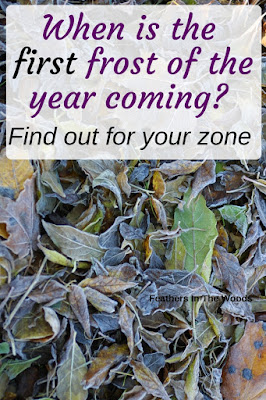Frost tolerant vegetable plants like: broccoli, peppers, pumpkin, squash, beans and many others will be perfectly fine through a few frosts. Unfortunately the tomatoes are going to need harvested because they probably won't make it.
That's why it's important to know your first expected frost date. To find out that date you'll need to know what growing zone you're in.
Luckily the are really easy to find out. I'll show you how.
Find your growing zone
There are two websites you're going to use. The first is the United States Department of Agriculture site. You want the plant hardiness zone map. Or just click right here: USDA to go to the map.
Once on the map you simply click your state and it will blow up to full size so you can see where you are. There's a little chart on the top of the state map that tells you the zone number of each color.
Most people will know right away where they are and what zone they're in. However if you're like me and live in the middle of nowhere without any landmarks, you'll want to pull up a second map.
I did a google search for 'PA county road map' then I clicked images. Don't click maps, that won't work. Scroll through the images till you find one with both the counties outlined and some roadways and/or cities. You'll want to click the view image button.
Once it's blown up full size you can find your hometown, then compare it to the USDA map to approximate your location. I marked my location on each map with a star.
I am in zone 5B. Zones are divided by 10°F increments. Of course it should be colder at the bottom of the zone and warmer at the top, with variations for elevation. B refers to the bottom 5° of the zone with A being the top 5° of the zone.
How to find your first frost date
The next thing you need to figure out is your approximate first frost date. Of course these are just educated guesses (not facts) so you'll still need to keep an eye on the weather, but it's usually a pretty close guess. I happen to like the Farmers Almanac website for this one.
Once there you need the Average Frost Dates map. This map works the same way the last one did. You just click on your state and a little window pops up.
Not every city is reported so you're might do a tiny bit of guesswork. My little town is not listed but I am smack dab in the middle between Pittsburgh and Erie. As you can see Pittsburgh is calling for a first frost date of 10/17 and Erie is calling for a first frost date of 10/29, so it's a pretty good guess that it's going to be somewhere in there.
What to do during an early frost
Of course, there have been years that the first frost was early and other years where it was late. Keep an eye on the weather and keep some light sheets or thin plastic, flannel backed tablecloths to throw over plants in the event of a late frost. Or grab a roll of clear plastic and some dollar store hula hoops to make this cheap and easy low tunnel.
You'll want to check your weather report daily when it gets close to your first expected frost date.
There are 2 types of frost. The mildest is a light frost when the temperature falls to below 32°F and frost crystals start to form. Then there is a hard freeze where the temperature drops to below 25°F for at least 4 hours.
Obviously this one will do more damage than the first.
Related reading: Check out this list of Frost tolerant plants
Bringing plants inside
Certain container plants will need to be brought indoors ahead of a frost also. My lemongrass does great outside for all but 5 months of the year, but then it must come inside or die from frost. I knew this when I got it, so it's in a pot.If you happen to realize you have a tender plant in the ground you can move it to a pot and bring it inside on cool nights.
It will probably benefit from going back outside in the sun during the day for a few weeks to help it acclimate. You can find information on particular plants on seed packets, plant tags or the website of the company the pant came from. For instance Bonnie Plants (the stuff they sell at HD and Lowes) has information on frost on their website.
So what good is this information...we can't stop the frost from coming, right? True, but we can carve out some time to harvest and process the rest of the fruits, veggies and herbs that are left so they don't go to waste.
Most vegetable plants should be just about done soon anyway, but I really hate to lose anything after working so hard on the garden all season! We can also set aside some time to debug plants and bring them inside in smaller groups before the frost creeps up on us and they all need to come in at once!
Related reading: Want more information on gardening? Check out this collection of articles on organic gardening.
~L
Want gardening and healthy living information sent right to your email weekly? Click right here to join my list and get new posts sent directly to you the day they're published!




Thank you for sharing! I am also in zone 5b. I always look forward to your emails.
ReplyDeleteI'm so glad you enjoy the emails! Nice to meet another 5b resident!
DeleteThank for stopping by.
Lisa
Thank you. I'm North of the border on the West Coast of Canada Zone 7B
ReplyDeleteYou're welcome! You get a pretty short growing season up there! Hope you have a good one...
DeleteLisa